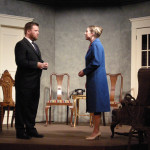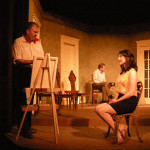One often hears tales of actors falling ill and, in the absence of a proper understudy, some poor individual being handed a script and forced to step in. However, in all my years of theatre, I had never actually experienced a show where that happened. Needless to say, it boggled the mind of everyone at Vagabond Players when exactly that situation materialized, not once but twice within a three-day period during Go Back for Murder.

On the first occasion, I was the unfortunate person who became the stand-in. I was enjoying a night at home with my husband—TV on, feet up, drink in hand—when the phone rang and interrupted our movie. The caller was Jacqollyne Keath, director of the play, to tell me that the actress playing Jessica Blake was unable to perform. Jacqollyne was unable to step in herself as she was at a rehearsal for another show, and she had no one else who was familiar enough with the play to carry it off. I was the set designer, knew the show and had watched several rehearsals and performances, so it was down to me.

Since it was already seven-thirty and the curtain was at eight, the theatre was full and the panic was on. As club president I had the option of cancelling the show and refunding all that lovely money or going down to the theatre and doing the part myself. Talk about moral blackmail! By the time I had done a quick change and reached the theatre, it was only a couple of minutes to curtain time. I was greeted enthusiastically by the cast members, all of whom had been despondent at the prospect of cancellation. They gleefully informed me that the audience had cheered when the house manager announced the substitution—nothing like pressure—but because they were all so pleased to see me and sweet with their offers of help, I stopped spitting nails and focussed on the job at hand. Rob Larsen, our stage manager, thrust a script into my hand and I hustled down to the green room to pore over it in the twenty minutes before my first scene.

Being a stand-in was certainly an interesting experience, if fraught with unanticipated hazards. Props were an issue—no one warned me about the decanter with a trick stopper so Corrine Out had to come to my rescue in my first scene—but the cast did their best in hurried whispers to tell me what I was carrying and where I should put it. Everyone helped. Brian Hoskins went over the script with me in the green room; Miles Lavkulich escorted me to the wings for my entrances and every performer took turns gesturing me to the right spot on stage or covering up smoothly if I missed a line. During Act II, Alanna Nicole, Alison Main Tourneur and Faith Hurd were great wing colleagues, handing me my props and explaining each section to help me along.

Another snag, peculiar to my own situation, was that the character I was playing, through problems with casting, had been changed from male to female. As a result, reading from the script involved some mental gymnastics because the actors were calling me Jessica but my lines belonged to Philip. Also, the print of the script was small, so I had to wear reading glasses, but whenever I looked up to move around, I was in danger of walking into a wall. If it hadn’t been for Alison Main-Tourneur’s guiding hand at my elbow, I would have done a face-plant into the wings during an Act II exit.

Blocking was not much of a problem in Act I since, most of the time, my character was seated at a desk. However, Act II was a different story. My character was all over the set, entering and exiting, in and out of the garden room, off stage and on stage; I felt like a gerbil on a wheel. How glad I was that I’d designed the set. At least I had some idea of where I was going. However, the concentration required was immense, and this manifested in a surprising way. I had been in such a rush to get to the theatre that I had not had time to put on makeup, but after the show, when I commented to my husband that I must have looked pale and washed out, he replied: “Not at all. You had lots of colour.” Raised blood pressure obviously works as a substitute for Tan No. 2.

The following week, I compared notes with Richard Wiens. He had been the stand-in a couple of days later when a different actor had been taken ill. Richard had his own list of hazards, the most disconcerting being the moment when one of the actresses sat on his lap and promptly blocked his view of the script in his outstretched hand. Richard, I was told, had done an outstanding job filling in, and he and I both agreed that, once we had accepted the situation, it had proved quite a buzz improvising our way through an entire play. We also felt smug about the other perk for a stand-in. Audiences give underdogs extra applause, so we had both been roundly cheered for our performances.

Of course, in order to be a successful stand-in, there has to be a framework to fit into, and it was the solidly co-ordinated team, so well put together by Jacqollyne Keath, that made it easy to fill the gap. Kudos to the lovely cast and crew of Go Back for Murder who were so supportive of my and Richard’s efforts. On my night as stand-in, every one of this great troupe helped me get through. Not only were all the cast members helpful, they praised and encouraged me every step of the way. I couldn’t have been thrown in amid a nicer bunch of performers. Next time, if there is one, I won’t be spitting nails when I get that call. Wild horses won’t be able to keep me away. Standing in…nothing to it!
